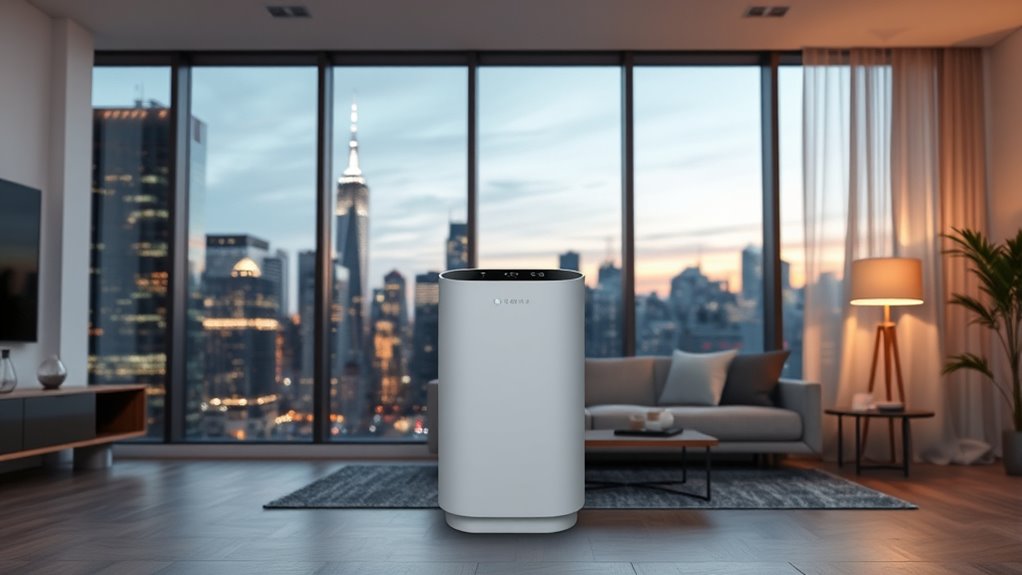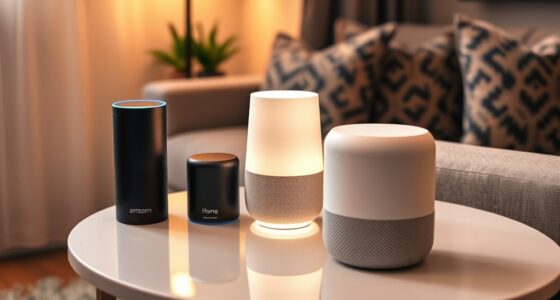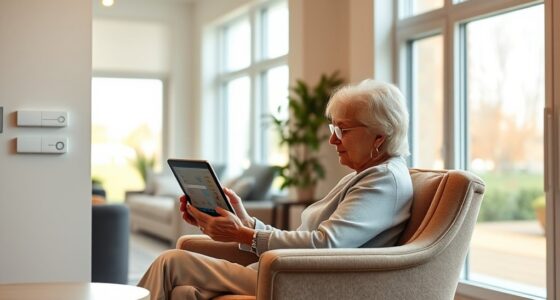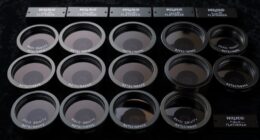For urban homes, the best smart air purifiers combine accurate sensors, reliable filtration, and seamless connectivity. Look for models with real-time air quality monitoring, automatic adjustments, and easy app control, so you can track and improve your indoor air anytime. Compact units fit small spaces, while high-performance versions cover larger areas effortlessly. Budget-friendly options still offer smart features and voice control. Keep in mind, proper placement and regular maintenance maximize their benefits—discover more tips to optimize your air quality.
Key Takeaways
- Look for compact, stylish models with smart app control, voice integration, and real-time air quality monitoring suited for urban living spaces.
- Choose devices with high CADR ratings and multi-stage filtration (HEPA and activated carbon) for effective pollution removal.
- Prioritize sensors with proven accuracy (±1-2 μg/m³) and advanced self-calibration for consistent, trustworthy data.
- Opt for models with easy maintenance, filter replacement alerts, and regular firmware updates to ensure long-term performance.
- Ensure proper placement in high-traffic or pollutant-prone areas and utilize app features for optimal coverage and proactive upkeep.
Top Features to Look for in Smart Air Purifiers for City Living
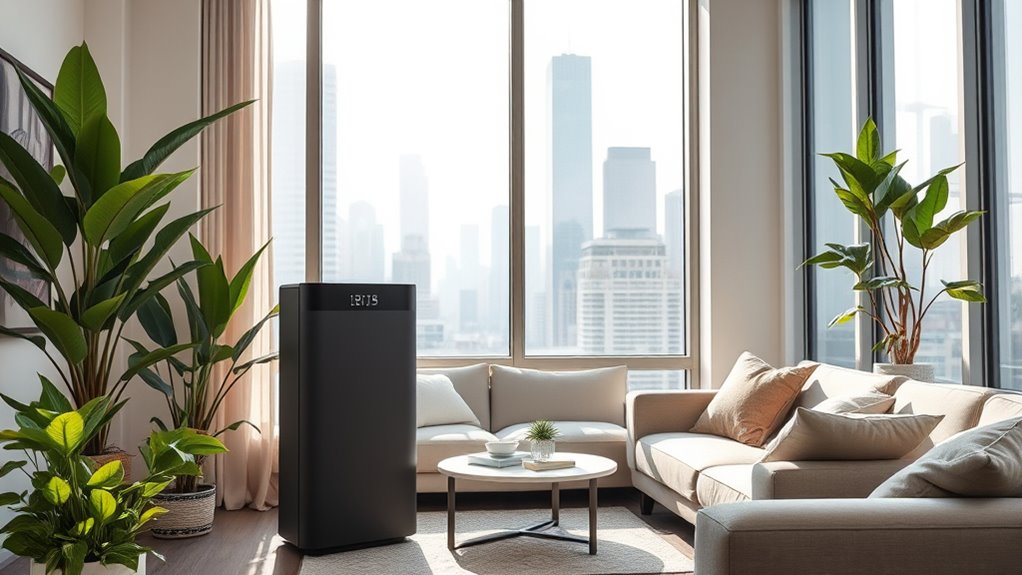
When choosing a smart air purifier for city living, it’s essential to focus on features that effectively tackle urban pollutants. Look for models with air quality sensors that provide real-time pollutant monitoring, including PM2.5 and VOC levels. These sensors help you understand your indoor air quality at a glance and enable the device to respond dynamically to pollution levels. Auto mode allows the device to adjust filtration automatically, maintaining ideal air quality without your intervention. Real-time monitoring ensures you are always aware of current air conditions and can respond accordingly. App control offers convenient operation and monitoring from your smartphone. Prioritize high CADR ratings and sufficient room coverage to combat city fumes, smoke, and dust efficiently. Multiple filtration stages, such as HEPA and activated carbon filters, are fundamental for removing particles and gaseous contaminants. Incorporating air quality indicators can help users better understand and respond to indoor air conditions. Additionally, smart home integration and voice control enhance seamless operation, making it easier to keep your indoor air clean and healthy in urban environments. Incorporating AI security features can further safeguard your device from cyber threats, ensuring consistent and safe operation.
Best Overall Smart Air Purifier for Urban Environments

Among the top options for smart air purifiers suited to urban environments, the IQ Air Atem X stands out as the best overall choice. Designed for urban homes, it combines sleek aesthetics with advanced air quality sensors that detect airborne particles and adjust purification accordingly. Incorporating attention skills into its operation, the device ensures optimal performance by continuously monitoring air quality and responding to changes in real time.
Its HEPA filters efficiently remove 99.97% of pollutants, viruses, and other allergens, providing superior air purification. The device features app control, allowing you to monitor and adjust settings remotely, and its air quality monitor keeps you informed in real time. With energy-efficient operation and a filter lifespan of around six months, it balances high performance with durability. Despite its premium price, it offers reliable pollutant removal, automatic adjustments, and long-lasting filters, making it ideal for city dwellers prioritizing indoor air quality. Additionally, AI-driven safety measures are increasingly integrated into smart air purifiers to enhance their effectiveness and user confidence. Regular maintenance and understanding of filter replacement indicators can further optimize its performance, ensuring clean air in busy urban settings. Incorporating smart technology integration can also help in managing energy consumption and enhancing user experience.
The Most Reliable Models for Continuous Indoor Air Quality Monitoring
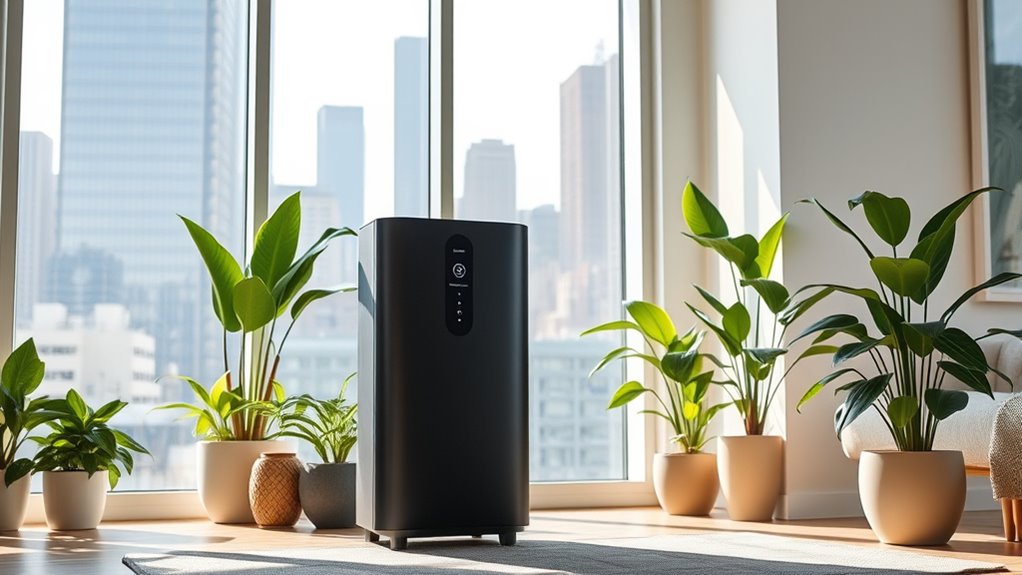
When choosing a smart air purifier, you want models with highly accurate sensors that stay calibrated over time. These devices should give you real-time data that’s easy to access through apps or displays, so you can stay informed about your air quality. Additionally, look for units with filter replacement indicators that help you maintain optimal performance without guesswork. Reliability also depends on long-term stability, ensuring the device consistently monitors without frequent maintenance or sensor drift. Incorporating AI-driven analytics can further enhance the device’s ability to adapt to changing indoor conditions and improve overall performance. Paying attention to sensor accuracy ensures that your air quality readings remain trustworthy over extended periods, which is especially important for urban homes where air pollution levels can fluctuate frequently. Moreover, choosing models with consistent calibration can help maintain measurement precision over time, reducing the need for manual adjustments.
Sensor Accuracy and Calibration
Accurate sensor readings are essential for reliable indoor air quality monitoring, and the best smart air purifiers achieve this through meticulous calibration. High-quality models utilize factory calibration and regular self-calibration routines to guarantee sensor accuracy over time, preventing sensor drift that can distort readings. Incorporating Glycolic Acid benefits into skincare routines can improve skin texture and appearance, similar to how reliable sensor calibration maintains optimal air quality readings. Particulate sensors and VOC sensors, often part of a multi-sensor array, work together to provide real-time measurements of pollutants, delivering precise data within ±1-2 μg/m³. Reliable calibration involves factory testing with standardized reference materials and ongoing software updates, ensuring sensor responses align with laboratory standards. Sensor calibration procedures should include regular cleaning and maintenance of sensor components to sustain accuracy over the device’s lifespan. Additionally, sensor response time plays a crucial role in capturing rapid changes in air quality, allowing the purifier to react swiftly to pollution spikes. The integration of advanced sensor technology ensures consistent, trustworthy indoor air quality data necessary for optimal air purifier performance.
Real-Time Data Accessibility
Reliable smart air purifiers for continuous indoor air quality monitoring incorporate advanced sensors that provide real-time data on pollutants like PM2.5 and VOCs, ensuring you stay informed about your environment at all times.
With instant data updates via app connectivity, you can easily access real-time air quality, view air quality displays with color-coded indicators or numeric readouts, and monitor changes instantly.
These models support remote monitoring through Wi-Fi or Bluetooth, allowing you to control and check your purifier from anywhere.
They also log air quality history for long-term insights and include features like auto-adjusting fans that respond dynamically to pollutant fluctuations.
Plus, seamless smart home integration enables voice alerts and automations based on real-time air quality data.
- Real-time air quality display with color-coded indicators
- App connectivity for remote control and monitoring
- Air quality history logs for long-term analysis
- Auto-adjusting fan speeds responding to pollutant levels
Additionally, sensor accuracy plays a crucial role in ensuring the reliability of the data collected by these devices. Optimizing sensor performance is essential for maintaining accurate air quality readings, and implementing regular calibration can further enhance sensor reliability for consistent data quality, especially in dynamic indoor environments.
Long-Term Monitoring Stability
To guarantee your indoor air quality remains consistently monitored over years, selecting a smart air purifier with proven long-term stability is essential. Look for models with reliable sensor performance and data accuracy, even after years of use. AI-driven monitoring technologies contribute to maintaining consistent detection and alert systems over extended periods. Factory-calibrated sensors ensure drift resistance and maintain calibration without frequent adjustments. Devices with high durability incorporate features like sensor redundancy and self-calibration to resist degradation from dust, humidity, and temperature fluctuations. Regular firmware updates help preserve measurement precision and extend device lifespan. Additionally, choosing models with long-term sensor stability can significantly enhance the device’s reliability over time. Incorporating quality sensor components ensures sustained accuracy and reduces the need for recalibration. The best models sustain their accuracy within ±5% of initial readings over multiple years, making them highly dependable for continuous indoor air quality management. Prioritizing long-term stability ensures your smart air purifier consistently provides trustworthy indoor air data, safeguarding your health over time.
Compact and Stylish Purifiers for Small Apartments and Offices
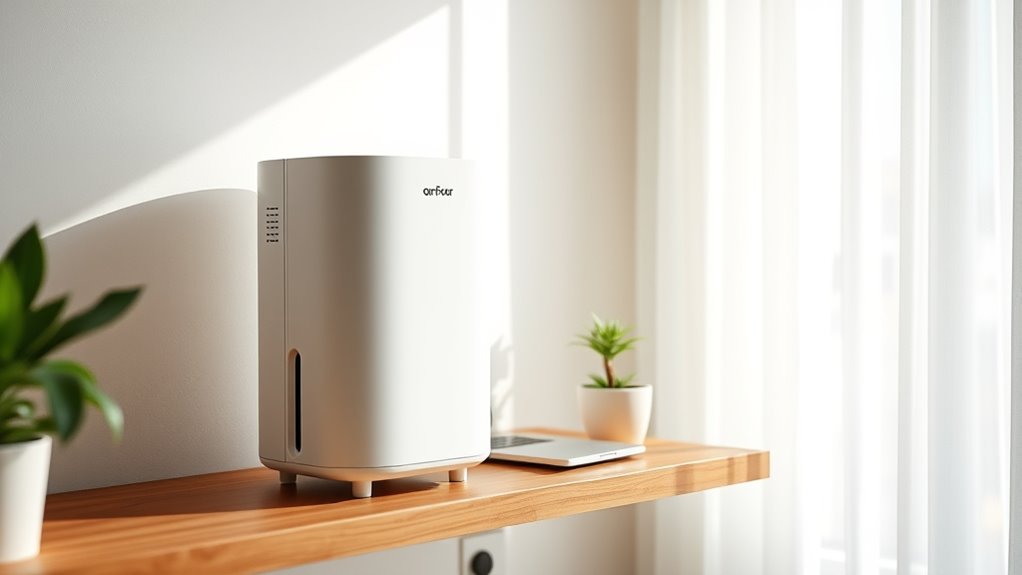
If you’re looking for a purifier that fits seamlessly into small apartments or offices, compact models like the Blueair Blue Pure 511 are excellent choices. Weighing less than 4 pounds and about the size of a soda bottle, it’s perfect for small rooms like dorms or workspaces.
Perfect for small spaces—lightweight, sleek, and easy to use.
Its modern design is sleek and minimalistic, blending effortlessly with contemporary decor. The quiet operation, below 50 decibels even on high, ensures it won’t disturb your sleep or work.
Easy to use with a simple three-speed fan and quick filter replacements, it provides effective air filtration without taking up too much space. Its automatic display dimming adds to its subtle, space-saving appeal.
This portable, stylish purifier combines form and function for your small-room needs.
- Compact, space-saving design
- Quiet operation for sleep or work
- Easy-to-use controls and filters
- Modern, sleek appearance
High-Performance Units for Large Rooms and Open-Plan Spaces

For large rooms and open-plan spaces, high-performance air purifiers deliver powerful, thorough filtration to maintain ideal air quality. These units, like the Blueair Blue Pure 211i Max and Coway Airmega ProX, feature smart sensors, app control, and air quality monitoring to adjust performance automatically. They maximize air exchange rates with high CADR ratings—350 CFM and above—ensuring rapid removal of smoke, odors, and pollutants. Their multi-stage filtration systems combine HEPA and activated carbon filters for extensive cleansing. Designed for urban homes, these units blend sleek aesthetics with advanced connectivity, making them easy to operate and monitor remotely. Use the table below to compare key features:
| Model | Coverage Area | Filtration System | Smart Features |
|---|---|---|---|
| Blueair 211i Max | 500 sq ft | Multi-stage HEPA + Carbon | App control, auto mode |
| Coway ProX | 800+ sq ft | Multi-stage HEPA + Carbon | Smart sensors, air quality monitoring |
Budget-Friendly Smart Air Purifiers With Advanced Connectivity

Budget-friendly smart air purifiers like the Levoit Core 400S and Blueair Blue Pure 211i Max pack advanced connectivity features into affordable designs, making it easy to maintain clean indoor air without breaking the bank. These models typically include app control, Wi-Fi connectivity, and air quality monitoring, so you can track and adjust settings remotely.
Their multi-stage filtration systems feature HEPA filters and activated carbon, effectively capturing allergens, pollutants, and odors common in urban environments. Many support voice commands via Alexa, Google Assistant, or Siri, enabling hands-free operation.
Their compact design fits well in limited spaces, while automation features like auto-adjusting fan speeds keep your air purifier working efficiently. Overall, these budget-friendly smart air purifiers combine affordability with high-tech convenience for cleaner indoor air.
Integrating Smart Purifiers Into Your Home Automation System
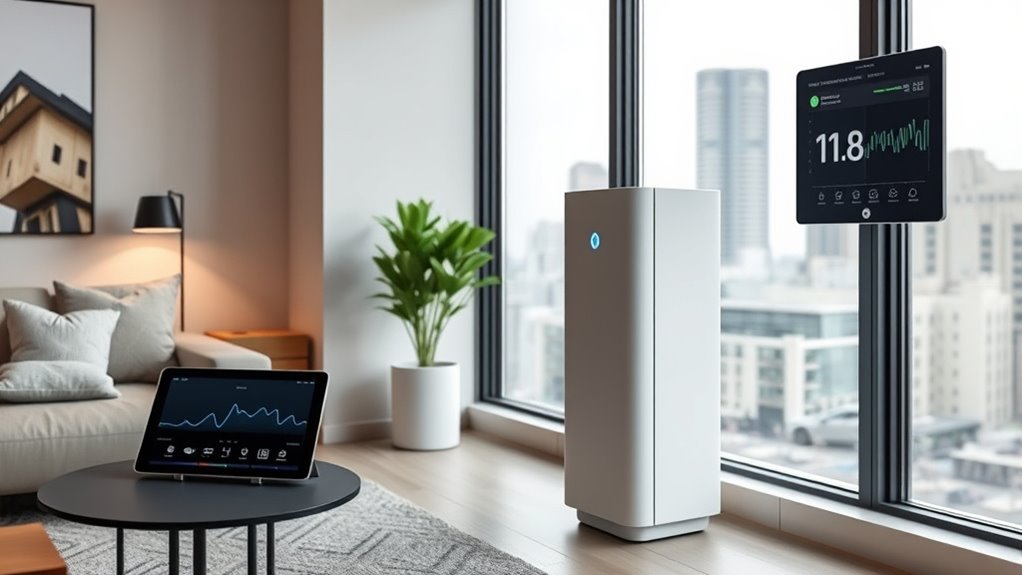
You can easily integrate your smart air purifier into your home automation system for a more seamless experience. By connecting it with platforms like SmartThings or Apple HomeKit, you’ll gain access to custom routines and automation based on air quality data.
This integration allows you to control your purifier remotely and create automated responses to improve your indoor environment effortlessly.
Seamless Device Integration
Integrating smart air purifiers into your home automation system enhances convenience and control by allowing seamless operation alongside other smart devices. This integration enables you to manage your purifier effortlessly through voice control, app control, or remote operation.
Devices like the Levoit Core 400S and Molekule Air Pro support smart home integration with platforms like Alexa, Google Assistant, and Apple HomeKit, ensuring device synchronization.
Real-time air quality data from smart sensors can trigger automation routines, adjusting purification levels automatically.
Compatibility with IFTTT enables advanced workflows, such as activating the purifier when pollutant levels rise.
This cohesive setup creates a healthier indoor environment with minimal effort.
- Compatibility with voice assistants and automation platforms
- Real-time air quality monitoring and automatic adjustments
- App control for easy device management
- IFTTT integration for custom workflows
Custom Automation Settings
Building on seamless device integration, customizing automation settings allows you to tailor your smart air purifier’s operation to your specific needs. With automation, you can set air quality thresholds that trigger the purifier to activate or adjust fan speed automatically.
Voice control through platforms like Alexa or Google Assistant makes it easy to manage routines hands-free. If you connect your purifier to IFTTT or use APIs, you can create custom routines, such as turning on the purifier when sensors detect high pollution levels or occupancy.
Sensor integration helps sync your air purifier with other smart home devices, optimizing energy saving and extending filter life. These automation features ensure your indoor air stays clean while streamlining operation and reducing energy costs.
Tips for Maintaining and Optimizing Your Smart Air Purifier
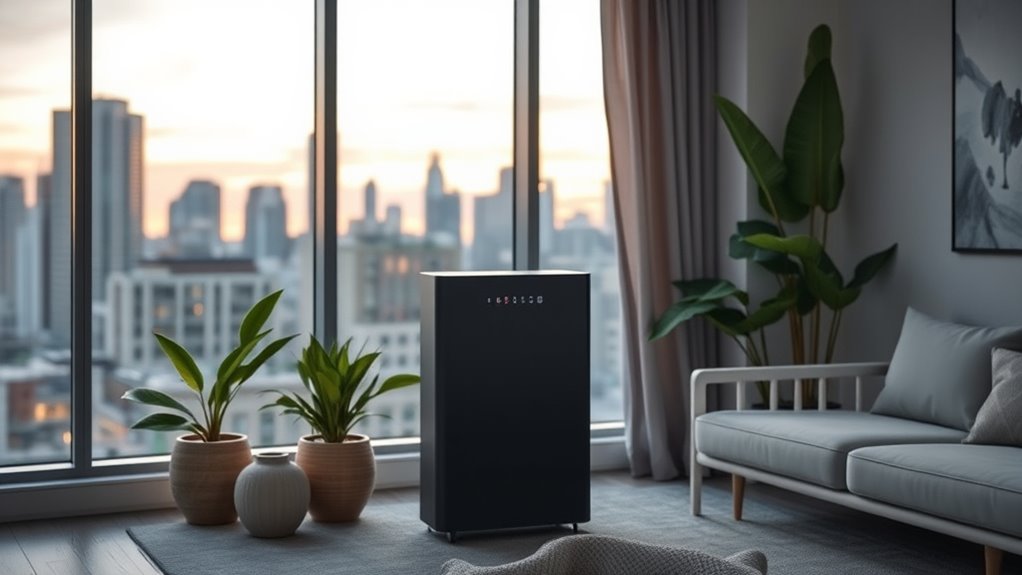
To keep your smart air purifier working at its best, regular maintenance is essential. Check and replace filters as recommended—typically every 6 to 12 months—to guarantee ideal filtration and clean air.
Use the app control feature to monitor air quality in real time and adjust settings remotely for continuous efficiency.
Keep sensors clean and unobstructed; dirty sensors can lead to inaccurate readings and reduced airflow.
Schedule automatic modes or set alerts for filter replacements and air quality drops to stay proactive.
Position your purifier centrally and away from obstructions to maximize coverage and filtration performance.
Regular upkeep ensures your smart features work seamlessly, maintaining ideal air quality and a healthier indoor environment.
- Replace filters regularly
- Keep sensors clean
- Use app control for monitoring
- Optimize placement for coverage
Frequently Asked Questions
What Is the Best Air Purifier for Large Homes?
When choosing the best air purifier for a large home, you want something with high coverage and smart features.
Look for models like the IQAir HealthPro Plus or Blueair Classic 680i, which cover over 1,000 sq ft and offer app control, air quality sensors, and auto-adjusting fans.
These units efficiently clean multiple rooms, ensuring you breathe healthier air throughout your entire home.
What Is the Best Smart Air Purifier?
The best smart air purifier offers high CADR, advanced filtration like HEPA and activated carbon, and smart features like app control and air quality sensors. It should connect easily to Wi-Fi, Alexa, or Google Assistant, so you can control it remotely or set schedules.
Look for models like IQ Air Atem X or Molekule Air Pro, which effectively remove pollutants and integrate seamlessly into your smart home for healthier indoor air.
What Air Purifier Does NASA Recommend?
You might think all air purifiers are the same, but NASA recommends using those with HEPA filters because they remove at least 99.97% of tiny particles like dust and pollen.
To get the best results, choose a unit with certified HEPA filters and consider adding activated carbon for gases and odors.
Make sure it matches your room size and offers enough airflow to keep your indoor air clean and healthy.
Is There a Downside to Air Purifiers?
You might wonder if air purifiers have downsides. They can produce ozone if they include ionizers or UV features, which can irritate your lungs.
Poorly maintained filters release pollutants back into your air.
Some models create noise or light disturbances, disturbing your sleep or focus.
Relying solely on them ignores source issues like smoke or mold.
Plus, high energy use can increase your bills and environmental impact over time.
Conclusion
Did you know that urban air can contain up to 2-5 times more pollutants than rural areas? Investing in a smart air purifier isn’t just about cleaner air—it’s about protecting your health and well-being in city life. With the right model, you can reduce pollutants, allergens, and odors effortlessly. So, choose wisely, stay consistent with maintenance, and breathe easier knowing you’re taking control of your indoor air quality in the heart of the city.
